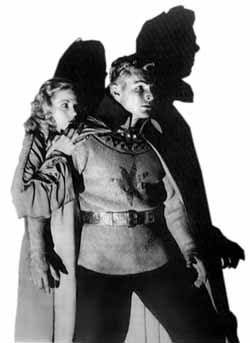 | Buster Crabbe almost gets electrocuted in Flash Gordon.
[click photo for larger version] |
Later, in Chapter Eight, a third triangle is added to the mix, as the portly Prince Barin (Richard Alexander), the rightful heir to Mongo—his father was killed by Ming and he himself banished—admits his love for Aura to Flash! It all happens during a crazy sword duel: Ming had guaranteed freedom and the choice of a bride to the victor, and Barin, disguised under a black hood, fights his best friend in order to win the woman he loves, or, should he lose, to meet his own death wish and be put out of his "misery." Aura further troubles the triangle by surreptitiously helping Flash fight a dreaded Orangopoid (another one of Ming’s tests—actually, a guy in a monkey suit with a rhinoceros horn on his head). Disobeying her father’s wishes, Aura attacks the creature, launching a spear into the all-too-vulnerable white spot along its neck. This subtle form of patricide—going against the law of the father—will play out in the rest of the narrative as Aura will move from loving Flash to finally loving Barin and reforming her bad-girl ways.
But it’s not just these complex love triangles that make this such a great serial. It’s much more than that. Larry "Buster" Crabbe is wonderful as Flash Gordon. Unlike the bourbon-soaked flab of so many other serial heroes (check out Columbia’s Batman and Robin [1949] for the greater-gut look), Crabbe actually is a comics-super-hero come to life. A former Olympic swimming champion, the bare-chested, bleached-hair Crabbe is resilient, strong and vulnerable. He also possesses the star-quality of a Douglas Fairbanks: he has the athletic verve, pep, and most importantly sincerity of the earlier star. Never once is Crabbe’s tongue in his cheek, never once does he hold himself above the story’s world. Instead, Crabbe makes the fantastic real. We believe that he can fly a spaceship, we believe that the perils he fights against are real, and most importantly, we believe in him, as the embodiment of Alex Raymond’s character.
 | Charles Middleton as Ming the Merciless in Flash Gordon.
[click photo for larger version] |
Meahwhile, Jean Rogers, as Flash's girlfriend Dale Arden, is one of the most endearing heroines in the history of serials, even if she had an annoying habit of passing out from fright. She certainly looks absolutely fabulous in a tight two-piece outfit that exposes her bare midriff and emphasizes her breasts. Rogers is a fragile creature who the villains delight in terrorizing. In one scene, King Vultan (before he becomes Flash's ally) threatens her with a bear. She screams and presses back against a wall, her stomach sucked in so that her ribs stick out and her breasts practically pop through her brassiere. She breathes deeper and deeper, practically hyperventilating as King Vultan closes in on her, his eyes crazed.
See Dale Arden menaced by the terrible King Vultan,
an excerpt from Flash Gordon.
(Animated GIF, 25 frames, 180 KB)
We also get plenty of scenes where Flash is imperiled. In one scene, Ming the Merciless has him thrown into a pit to fight four fanged monkey men. They promptly rip off Flash's shirt, exposing his well-oiled biceps. Scenes such as these reveal that Universal was hoping to attract more than popcorn-chomping children to the theaters. And on those terms, the studio was wildly successful. Instead of playing matinees, Flash Gordon was booked into some of the finest theaters, and audiences of all ages flocked to the engagements.
 | Poster artwork for Flash Gordon.
[click photo for larger version] |
Finally, Ralph Berger’s art direction is stunning, an appealing blend of styles: the interiors to Ming’s fortress are a combination of Asian and Egyptian architecture. The exteriors are borrowed from James Whale’s Frankenstein. The spaceships burst from the pages of Buck Rogers and Universal’s earlier SF flop Just Imagine (1930). The Atom Furnace room, where Thun, Flash, and Barin are held work as slaves, modifies the urban angst and alienation of Fritz Lang’s Metropolis (1925). And all of the various monarchs are amalgams of literary history. King Kala, ruler of the shark people, resembles a New York gangster in Caligula robes. Prince Barin, with his chiseled breast plate and gleaming headgear captures the glow of a Roman warrior, and the laughing, lustful King Vultan strikes a pose somewhere between a winged Friar Tuck and the gluttony of Henry the Eighth. Flash Gordon benefits greatly from foregoing other serials’ reliance on location shooting (where overuse of the same terrain frequently resulted in visual monotony). The use of Universal’s soundstages combined with Berger’s art direction created a unique comic-book reality that still, sixty years later, looks great, hot, and very sexy.
page 1 of 2





